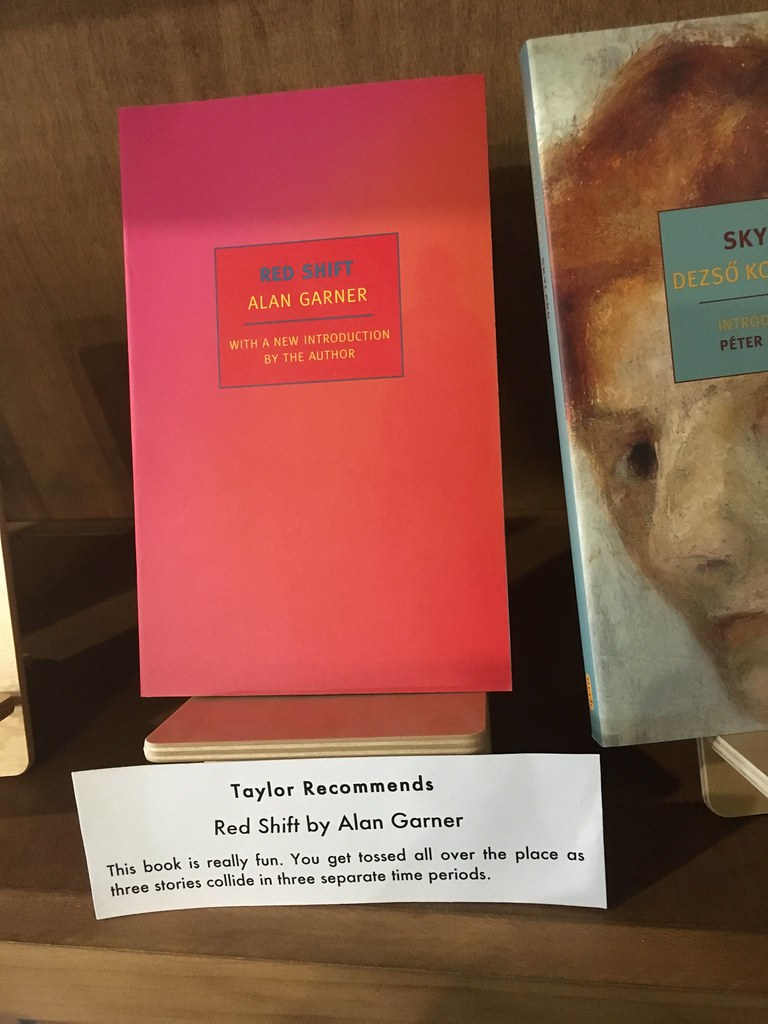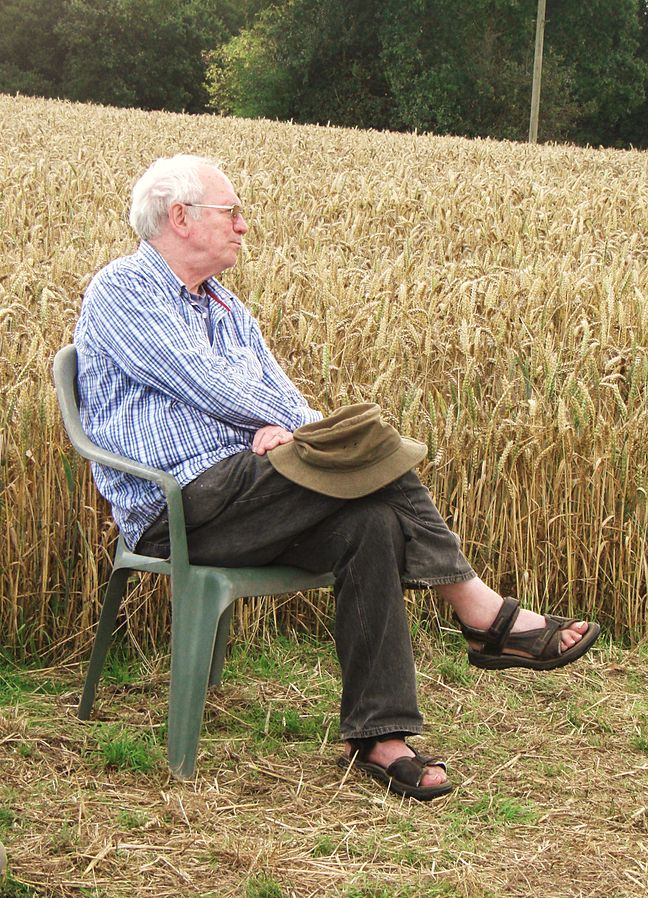Title of the work
Country of the First Edition
Country/countries of popularity
Original Language
First Edition Date
First Edition Details
Alan Garner, Red Shift. London: Collins, 1973, 155 pp.
ISBN
Official Website
harpercollins.co.uk (accessed: March 13, 2020).
Genre
Fantasy fiction
Novels
Target Audience
Young adults
Cover

Retrieved from flickr.com, uploaded by NYRB Classics. Licensed under CC BY-ND 2.0 (accessed: January 7, 2022).
Author of the Entry:
Sarah F. Layzell, University of Cambridge, sarahlayzellhardstaff@gmail.
Peer-reviewer of the Entry:
Susan Deacy, University of Roehampton, s.deacy@roehampton.ac.uk
Elżbieta Olechowska, University of Warsaw, elzbieta.olechowska@gmail.com

Alan Garner by Midnightblueowl, 2011. Retrieved from Wikimedia Commons, licensed under CC BY-SA 3.0 (accessed: December 22, 2021).
Alan Garner
, b. 1934
(Author)
Born in Congleton and raised in nearby Alderley Edge in Cheshire, Garner studied classics at Magdalen College, Oxford, before becoming a writer. Much of his work is influenced by the history, geography, mythology and dialect of his native Cheshire. Garner’s books for children include The Weirdstone of Brisingamen (1960), Elidor (1965), The Owl Service (1967) and The Stone Book Quartet (1976–1978). Garner’s books and other works have won numerous awards including the Carnegie Medal and the Phoenix Award. Garner was awarded an OBE (Order of the British Empire) in 2001.
Sources:
alangarner.atspace.org (accessed: March 13, 2020);
harpercollins.co.uk (accessed: March 13, 2020).
Bio prepared by Sarah Hardstaff, University of Cambridge, sflh2@cam.ac.uk
Adaptations
Red Shift was adapted as a BBC television play broadcast in 1978, written by Alan Garner, directed by John MacKenzie and produced by David Rose. A DVD version was released by BFI Video in 2014.
Translation
German: Rotverschiebung, trans. Bernd Rauschenbach, Diederichs, 1980.
Swedish: Orion i ögat, Berg, 1975.
Summary
Red Shift tells the stories of three men, connected by place and separated by time. These three characters are connected by place, particularly Mow Cop, a hill in Cheshire.
The twentieth-century narrative focuses on the tense relationship and regular meetings between teenager Tom and his girlfriend Jan. Tom lives in a caravan with his overbearing parents and is studying in preparation for university; meanwhile Jan is moving to London for her own studies The novel concludes with Tom behaving erratically at Crewe railway station. The novel’s endpapers feature an encoded note from Tom to Jan which is often interpreted as a suicide note.
The English Civil War narrative is set in the context of a massacre by Royalist soldiers and focuses on the relationship between Thomas and Margery, who take refuge under the watch of a local leader on the side of Parliament. The approaching soldiers include Thomas Venables, a former beau of Margery’s. Venables rapes Margery and then helps her and Thomas to escape the massacre.
In Roman Britain, Macey is a Celt who has been recruited into the Roman army as a berserker who can be provoked into fits which give him superhuman strength. Macey is now one of a group of deserters from the Ninth Roman legion. The group capture a native girl and set up camp on Mow Cop. While the others in the group rape and mistreat the girl, Macey befriends her. She poisons the others and spares Macey. They leave Mow Cop together.
Each of the three relationships is fraught with tension and violence. The characters are also connected through time by possession of a stone axe and experiences such as the vision of blue, red and silver of the trains at Crewe station which somehow connect to the Roman timeline and are linked to Macey’s fits.
Analysis
The most prominent example of the novel’s classical influence is Garner’s depiction of the Romans in Britain. Several critics have written about Garner’s deliberate parallels between the speech and attitudes of the Roman soldiers and those of American soldiers in Vietnam (see McCallum 1999, 138). While Vietnam is not mentioned explicitly within the text, the implied parallels between Roman Britain and the Vietnam War heighten the sense of connection between conflicts throughout time that can also be felt in Red Shift’s English Civil War story and the twentieth-century story.
In parts, the narratives meld into and influence each other: the three characters sometimes seem to be having the same experiences in the same places, and Garner switches from one character’s perspective to another without obvious signposting. The three characters thus sometimes appear to be a single person simultaneously experiencing three timelines. This too helps establish a close sense of connection with the people and spaces of Roman Britain.
Drawing convincingly on Garner’s own views, Haru Takiuchi establishes that “in Red Shift, Latin culture represents the dominant culture in all three storylines” – respectively in the forms of Roman imperialism, the Church and the modern education system (2017, 109). For example, Tom’s investment in formal education can be seen in his near-constant use of quotes from a range of literary and classical sources. Jan says, “You’re all quote!... You can’t put two words of your own together!” (Garner, 153). Tom’s quotes are thus seen as part of an intellectual culture that have separated him from his own language and culture (see also Nikolajeva 1989, 130).
Yet Garner brings the two cultures together in important ways. As Takiuchi puts it, “Garner uses middle-class culture to revive the residual culture he sees as preserved, although under threat of disappearing, in the rural working-class” (2017, 106). After Tom uses his hands to break a window in his parents’ caravan, he says he is “right as rain” (Garner, 38). Tom attributes the saying to Roman writer Plautus and indeed, Paul Nixon’s translation of Captivi (The Captives/The Prisoners) includes the phrase “Why, this will be just as easy for you as rain when it pours” (“tam hoc quidem tibi in proclivi quam amber est quando pluit” [Act 2, Scene 2, 336]). Tom’s insistence on finding an attribution for an everyday phrase may seem unnecessarily pedantic and reflective of his dissociation from his own culture and sense of place. However, the plot of Captivi concerns prisoners of war, reflecting the other storylines of Red Shift. Furthermore, Tom breaking the glass marks a transition point into Macey’s storyline, emphasizing the parallels between them. The intellectual reference ultimately leads back to shared experiences of the Cheshire landscape.
Finally, connections through time and the sense of multiple times coexisting are emphasised through the stars, namely the constellation Orion. Orion’s prominent blue and red stars reflect the colours that link the characters. The twinkling of Orion’s stars is used by Macey’s fellow soldiers to try and provoke one of his berserker fits early in the novel (Garner 1973, 29). Later, as Tom and Jan agree to both look at Orion at a set time each night while they are apart: Tom notes that due to the distance of the stars in light years, “we’re looking at it as it was when the Romans were here” (p. 39). The Swedish translation of the novel emphasises this point of connection by including Orion in the title: Orion i ögat (Orion in the Eye).
Further Reading
Butler, Catherine, “Alan Garner's Red Shift and the Shifting Ballad of Tam Lim”, Children’s Literature Association Quarterly 26.2 (2001): 74–83.
Garner, Alan, “Inner Time”, The Voice That Thunders, London: Vintage, 1997, 106–125.
McCallum, Robyn, “Subjectivity, Cognition and Certainty”, Ideologies of Identity in Adolescent Fiction: The Dialogic Construction of Subjectivity, New York, NY: Garland, 1999.
Nikolajeva, Maria, “The Insignificance of Time: Red Shift”, Children’s Literature Association Quarterly 14.3 (1989): 128–131.
Nixon, Paul, Plautus, Cambridge, MA: Harvard University Press, 1916 (accessed: January 10, 2020).
Takiuchi, Haru, British Working-Class Writing for Children: Scholarship Boys in the Mid-Twentieth Century, London: Palgrave Macmillan, 2017.
For more on other children’s books dealing with the Romans in Britain, see:
Butler, Catherine, “The “Grand Tour” as Transformative Experience in Children’s Novels about the Roman Invasion”, in Lisa Maurice, ed., The Reception of Ancient Greece and Rome in Children’s Literature: Heroes and Eagles, Leiden: Brill, 2015, 257–279.
Addenda
Other tags:
Common points between Rome and USA;
Roman occupation of Britain.


